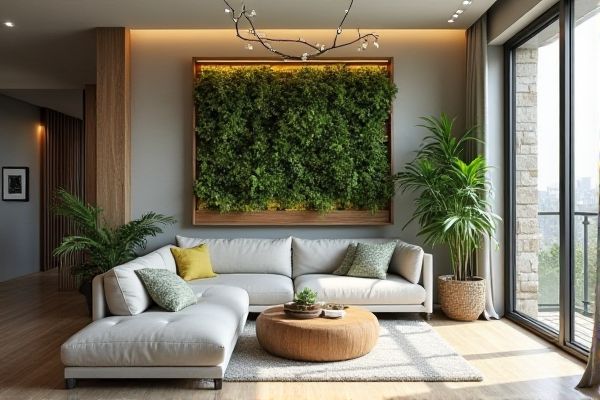
Vertical gardens maximize limited space by allowing plants to grow upward on walls, creating a lush, green ambiance without occupying floor area, while balcony shelves provide a more organized and accessible way to display potted plants horizontally. Discover which option best suits your space and gardening needs by reading the rest of the article.
Table of Comparison
| Feature | Vertical Garden | Balcony Shelf |
|---|---|---|
| Space Utilization | Maximizes vertical space, ideal for small areas | Uses horizontal space on balconies or terraces |
| Plant Capacity | Supports multiple plants stacked vertically | Holds plants side by side, limited by shelf length |
| Installation | Requires wall mounting or frame setup | Freestanding structure, easy to move |
| Maintenance | Access to all plants may be challenging | Easy access for watering and pruning |
| Design Flexibility | Customizable with modular panels or pockets | Limited to shelf tiers and arrangement |
| Weight Capacity | Dependent on wall strength and frame | Stable, supports heavier pots |
| Ideal For | Urban gardening, small balconies, limited floor space | Larger balconies, patios, easy plant rearrangement |
Introduction: Vertical Garden vs Balcony Shelf
Vertical gardens maximize limited space by utilizing walls for lush, multi-level plant growth, enhancing air quality and aesthetic appeal in compact areas. Balcony shelves offer versatile horizontal storage solutions, ideal for organizing pots and small plants while providing easy access and decoration. Your choice depends on available space, plant variety, and visual preference for creating a green sanctuary.
Space Efficiency Comparison
Vertical gardens maximize space by utilizing height, allowing you to grow more plants in a compact footprint, ideal for small balconies or limited outdoor areas. Balcony shelves offer organized horizontal storage but consume more floor space, potentially restricting mobility and reducing overall planting capacity. For optimal space efficiency, vertical gardens outperform balcony shelves by leveraging vertical space without compromising your usable balcony area.
Aesthetic Appeal and Design Options
Vertical gardens offer a lush, natural aesthetic that transforms walls into vibrant living art, enhancing urban spaces with greenery and improving air quality. Balcony shelves provide versatile design options, allowing for organized display of plants, decorative items, and functional storage, ideal for maximizing limited outdoor space. Both solutions cater to different stylistic preferences, with vertical gardens emphasizing organic beauty and balcony shelves focusing on structured elegance and practical use.
Installation Process and Ease
Vertical gardens require secure wall mounting or support structures, often involving drilling and anchoring, which can be time-consuming and may need professional assistance. Balcony shelves are generally easier to install, typically involving simple assembly and placement without permanent fixtures, making them ideal for renters or anyone seeking a quick setup. Choosing between the two depends on the balance between stability and installation complexity versus convenience and flexibility.
Maintenance Requirements
Vertical gardens require regular watering, pruning, and nutrient management to keep plants healthy and thriving, often needing an integrated irrigation system for efficiency. Balcony shelves generally demand less intensive upkeep, with easier access for watering and routine care, making them suitable for smaller spaces or busy lifestyles. Your choice depends on how much time and attention you can dedicate to plant maintenance.
Plant Variety and Suitability
Vertical gardens support a wider variety of plants, including climbing vines, hanging flowers, and even small vegetables, due to their multi-tiered structure that maximizes vertical space. Balcony shelves are ideal for potted plants like succulents, herbs, and small flowering plants that require more sunlight and easier access for maintenance. Your choice depends on the types of plants you want to grow and the available space, with vertical gardens offering greater versatility for diverse plant species.
Cost Analysis
Vertical gardens typically involve higher initial costs due to specialized structures, irrigation systems, and plants, ranging from $200 to $1500 depending on size and complexity. Balcony shelves offer a more budget-friendly option, generally priced between $50 and $300, requiring minimal installation and maintenance expenses. Long-term costs for vertical gardens can increase due to water usage and upkeep, whereas balcony shelves have lower operational costs but offer less plant capacity.
Environmental Impact
Vertical gardens significantly reduce carbon footprints by improving air quality and providing natural insulation that lowers energy consumption. Balcony shelves, while space-efficient for plant display, often rely on non-biodegradable materials that contribute to environmental waste. Choosing a vertical garden enhances your eco-friendly lifestyle through increased greenery and sustainable urban living benefits.
Long-Term Durability
Vertical gardens constructed with weather-resistant materials like treated wood or metal offer superior long-term durability compared to typical balcony shelves, which often use less robust materials. You should consider vertical gardens for sustainable outdoor use because they withstand varying weather conditions, reducing the need for frequent replacements or repairs. Balcony shelves may be more susceptible to wear, corrosion, and structural weakness over time, especially in humid or rainy climates.
Choosing the Best Option for Your Balcony
Vertical gardens maximize limited balcony space by allowing you to grow a variety of plants upward, making them ideal for small areas and enhancing air quality. Balcony shelves offer versatile storage and display options for potted plants, enabling better organization and easier access to your greenery. Assess your balcony size, sunlight exposure, and plant types to determine whether a vertical garden or balcony shelf best suits your gardening goals.
 homyna.com
homyna.com